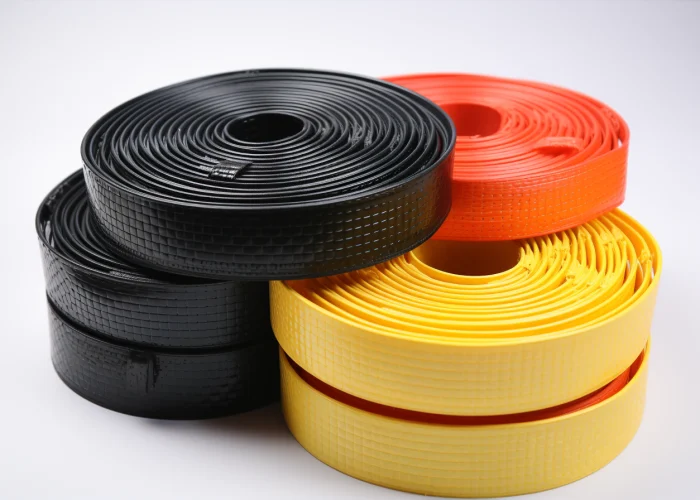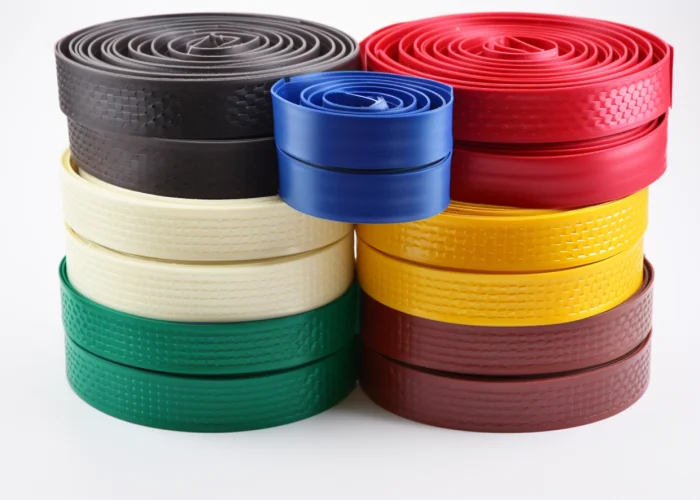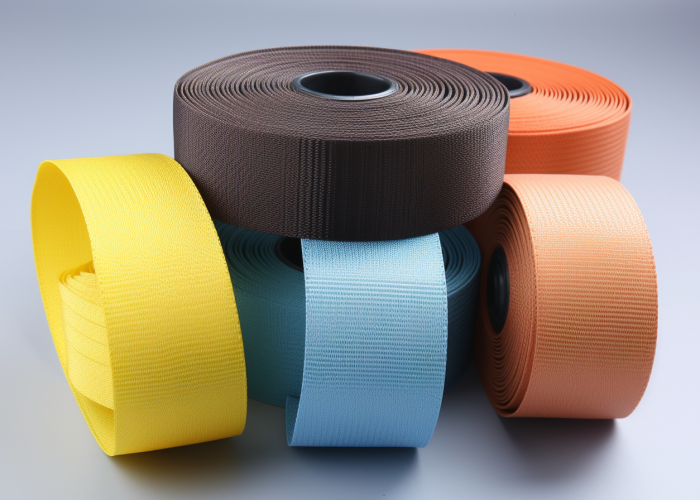Selecting the right printing technique for webbing is crucial for creating durable, flexible products. Silicone printing has emerged as a key method for manufacturers seeking to combine functionality with visual appeal in applications from outdoor gear to medical devices.
Silicone printing webbing applies silicone-based inks to woven fabric strips through screen printing or dipping, followed by heat curing to create durable, flexible, UV-stable surface decoration. This technique maintains flexibility while providing superior environmental resistance, ideal for sportswear, pet accessories, and medical devices requiring both durability and comfort.
We’ll cover the advantages of silicone printed webbing, material compatibility, quality challenges, and how to choose the right silicone formulation for your application.


Webbing manufacturing expert with 15+ years of experience helping product developers build high-performance straps for industrial, medical, and outdoor use.
Silicone printing on webbing applies liquid silicone ink to fabric strips using screen printing or dipping methods, followed by heat curing to create durable, flexible designs. The process forms a strong bond between silicone and webbing that maintains flexibility while resisting environmental damage.
The fundamental technique involves depositing silicone ink onto the webbing surface through specialized equipment. The ink typically requires heat curing, commonly using UV light to catalyze the formation of a cross-linked polymer network. This curing process transforms the liquid silicone into a solid, durable coating that maintains flexibility even under stress. The resulting printed webbing offers exceptional performance characteristics that make it suitable for applications requiring both durability and comfort.
What makes silicone printing particularly valuable is its ability to maintain print integrity even when the underlying webbing stretches or flexes. Unlike traditional printing methods that may crack or peel under strain, properly cured silicone prints move with the webbing material. This makes silicone-printed webbing ideal for applications where repeated movement occurs, such as in sportswear harnesses, pet accessories, and medical devices that must conform to body contours.
The process requires precise control of several variables, including ink viscosity, curing temperature, and application pressure. Too thick an application can result in cracking, while insufficient curing leads to tacky surfaces that attract dirt. Properly executed silicone printing creates a seamless integration between the decoration and the underlying webbing material, enhancing both function and aesthetic appeal.
Silicone printed webbing offers superior durability against stretching, washing, and environmental exposure while providing customizable tactile properties. It maintains excellent adhesion to nylon, polyester, and cotton materials, making it ideal for high-performance applications requiring long-term reliability.
The primary advantage of silicone printed webbing is its outstanding durability. Unlike conventional printing methods, silicone prints withstand repeated stretching and washing without cracking, peeling, or fading. This resilience extends to environmental exposure, with silicone maintaining its integrity when subjected to UV radiation, moisture, temperature fluctuations, and chemical contact. For products expected to perform in outdoor environments or undergo frequent cleaning, this durability translates directly to extended product lifespan and customer satisfaction.
Another significant benefit lies in the tactile qualities silicone provides. The material can be formulated to create specific sensory experiences, from soft-touch grips to high-friction surfaces. This tactile customization is particularly valuable for products where user interaction is critical. Silicone prints can be engineered to provide targeted grip on textured surfaces, enhancing both functionality and user experience without compromising comfort or flexibility.
Material compatibility represents another key advantage. When properly pretreated, silicone adheres effectively to nylon, polyester, and cotton webbing, making it versatile across different product categories. This broad compatibility allows manufacturers to select the optimal base webbing material for their specific application requirements while still benefiting from silicone’s performance characteristics. The result is a highly customizable manufacturing solution that adapts to diverse product needs without sacrificing quality or durability.

Synthetic webbing materials like nylon and polyester work best with silicone printing when properly prepared with heat treatment between 90-300°C to promote adhesion. Cotton and elastic blends require specialized pretreatment with reactive coupling agents, while all materials benefit from controlled processing temperatures to prevent damage while ensuring optimal silicone bonding.
Nylon and polyester webbing represent the most commonly used bases for silicone printing applications. These synthetic materials require careful optimization of processing parameters, typically involving heat treatment between 90-300°C to promote proper ink adhesion. The heat-sensitive nature of these synthetics necessitates precise temperature control during curing, generally kept between 90-120°C to prevent material damage while achieving complete silicone curing. For optimal results, screen printing with 150-65T mesh ensures appropriate ink deposit while post-curing at 40-50°C maximizes durability.
Cotton and elastic blend webbings present different challenges and opportunities. These natural or mixed-material webbings typically require pretreatment with reactive coupling agents to enhance mechanical bonding at the fiber level. Elastic webbing requires special handling during the printing process to control tension, allowing the silicone to form a durable bond that can accommodate the material’s inherent stretch properties. Manufacturers often employ thermal curing followed by UV or thermal secondary curing to preserve elasticity while ensuring complete silicone polymerization.
The composition and structure of the webbing significantly impact print quality and performance. Tightly woven materials with moderate surface texture generally provide the best foundation for silicone printing, offering sufficient mechanical bonding sites without excessive ink absorption. The weave pattern also influences how the webbing responds to tension when printed with silicone, with herringbone patterns typically providing more controlled stretch while maintaining print integrity better than plain weave configurations under similar loads.
Moderate surface roughness between 5-20 microns creates optimal silicone adhesion on webbing by providing mechanical bonding sites. Smooth surfaces cause poor adhesion due to insufficient bonding area, while overly rough surfaces may create inconsistent print coverage.
Excessively smooth webbing surfaces present one of the greatest challenges for silicone printing applications. Materials like laminated or coated fabrics tend to render adhesion difficult due to insufficient surface area for the silicone to form mechanical bonds. This limitation is particularly evident in high-gloss synthetic webbings or those treated with water-repellent finishes, which create a barrier between the silicone and the underlying fiber structure.
The ideal surface for silicone printing features moderate roughness that provides ample mechanical bonding opportunities. Research indicates that surfaces with microscopic variations between 5-20 microns create optimal conditions for silicone adhesion. These textural features significantly increase the effective surface area available for bonding while creating microscopic “anchors” that enhance the mechanical integration of the silicone into the webbing structure.
For materials with insufficient natural texture, various pre-treatment methods can improve surface characteristics. Controlled sandblasting with fine media can introduce beneficial micro-textures without compromising structural integrity. Chemical etching presents another option, using mild solutions to selectively modify surface chemistry and topography. These pre-treatments must be carefully calibrated to avoid weakening the webbing while enhancing its receptivity to silicone inks.
Testing shows that properly textured surfaces can improve silicone adhesion strength by 40-60% compared to untreated smooth surfaces. This enhanced bonding translates directly to improved print durability under mechanical stress, extending product lifespan and maintaining visual quality through repeated use cycles—a critical factor for performance-oriented products.
When selecting silicone ink for webbing, prioritize abrasion resistance, pigment concentration under 10%, and proper catalyst ratios for optimal performance. High cross-link density formulations (90-398-0) provide superior friction resistance for high-wear applications while maintaining color intensity.
Abrasion resistance represents a critical property for any webbing application subject to friction or repeated contact. Silicone inks with high cross-link density (specifically those in the 90-398-0 range) deliver exceptional resistance to repetitive friction, making them ideal for load-bearing straps, footwear components, and high-wear applications. The molecular structure of these formulations creates a densely interconnected network that maintains surface integrity even under harsh mechanical stress.
Pigment loading significantly impacts both aesthetic and performance characteristics. Adding colored pigments at concentrations below 10% by weight maintains color intensity without compromising the silicone’s structural integrity or adhesion properties. Exceeding this threshold often leads to decreased cross-linking efficiency and potential cohesive failures within the printed layer. For applications requiring intense coloration, specialized dispersions designed specifically for silicone systems offer optimal color development with minimal impact on mechanical properties.
Catalyst ratios play a crucial role in determining curing efficiency and final performance. Incorrect proportions of catalyzing agents can lead to incomplete curing, resulting in tacky surfaces or premature failure under stress. Manufacturers should work with specific technical datasheets to ensure proper mixing ratios, as these vary between silicone formulations. Some advanced systems employ platinum-based catalysts that offer superior curing with minimal shrinkage, though these typically come at a higher cost than traditional tin-based alternatives.
For applications requiring specific performance attributes, specialized silicone formulations offer targeted solutions. High-temperature variants maintain integrity at sustained exposures up to 260°C, while medical-grade options provide biocompatibility for direct skin contact applications. Understanding your product’s specific environmental and performance requirements enables selection of the optimal silicone system for your particular application.

Proper webbing preparation directly impacts silicone print quality through surface degreasing, controlling humidity below 60%, and selecting appropriate screen mesh density. Removing oils with alcohol or plasma cleaning prevents adhesion failures and ensures consistent quality results.
Surface degreasing serves as the essential first step in webbing preparation. Silicone’s inherently hydrophobic nature makes it particularly sensitive to surface contaminants like oils and processing residues. Effective cleaning typically involves isopropyl alcohol or specialized degreasing solutions to remove these impurities. For applications demanding exceptional adhesion, plasma cleaning provides superior results by microscopically altering the surface chemistry to enhance silicone bonding without introducing chemical residues.
Humidity control represents another critical factor affecting silicone adhesion and curing. Research indicates that maintaining relative humidity below 60% during the printing and initial curing phases optimizes results. Excessive moisture (above 70%) can interfere with the cross-linking reaction, leading to inconsistent curing, reduced adhesion, and potential surface defects. Climate-controlled production environments with dehumidification capabilities ensure consistent quality, particularly for high-precision applications.
Screen mesh optimization directly influences print definition and ink deposit. Coarser meshes (65T) reduce the number of printing passes required for complete coverage but may compromise fine detail. Conversely, finer meshes deliver superior detail resolution but typically require multiple passes to achieve adequate ink deposit. The optimal mesh selection balances these factors based on specific application requirements, with critical factors including the desired level of detail, required ink thickness, and surface characteristics of the webbing material.
Proper preparation creates the foundation for silicone print quality and longevity. Manufacturers who invest in comprehensive cleaning protocols, environmental controls, and appropriate screen preparation consistently achieve superior results across various webbing materials and end-use applications.
The silicone curing process significantly affects printed webbing performance through gradual temperature progression from 30°C to 90°C. This prevents bubbling while ensuring complete polymerization, with protective topcoats enhancing scratch resistance and durability.
Multi-stage thermal profiling represents the optimal approach to silicone curing. Beginning with lower temperatures (approximately 30°C) allows surface drying without trapping volatile compounds, which could otherwise create bubbles or pinholes in the finished print. Gradually increasing to full cross-linking temperatures (around 90°C) ensures complete polymerization throughout the silicone layer without thermal shock to the underlying webbing. This controlled approach prevents common defects like bubbling, cracking, or incomplete curing that compromise both aesthetics and durability.
Protective coatings significantly enhance the performance of silicone printed webbing. Applying a thin silicone topcoat (such as XG-9694) creates a sacrificial layer that substantially improves scratch resistance while maintaining the flexibility of the underlying print. These specialized formulations are engineered to integrate seamlessly with the base silicone layer, creating a unified structure with enhanced surface properties without compromising flexibility or adding significant weight to the finished product.
Quality assurance testing provides crucial verification of print performance. Peel tests using precisely controlled 90° angles measure adhesion strength at the silicone-webbing interface, while microscopic inspections identify potential defects invisible to the naked eye. These systematic evaluations confirm that the curing process has achieved complete polymerization and proper integration with the substrate, ensuring consistent performance in the final application. For critical applications, accelerated weathering tests can simulate years of environmental exposure in a compressed time frame.
The relationship between curing parameters and end-use performance is direct and significant. Optimizing these processes based on specific material combinations and application requirements yields printed webbing with superior durability, aesthetic quality, and functional performance.
The best silicone alternatives for webbing printing include photopolymer resins, waterborne polyurethane dispersions, and UV-curable inks. These options offer comparable flexibility and durability with advantages in curing speed, environmental compliance, and high-resolution printing capabilities.
Photopolymer resins represent a leading alternative to traditional silicone systems. Urethane-based photopolymers like Liquidose Flexomer provide excellent elasticity while offering compatibility with standard 3D printing equipment. These materials demonstrate superior resistance to heat and environmental factors while requiring significantly less curing time than conventional silicone formulations. For manufacturers focused on production efficiency or those already utilizing additive manufacturing technologies, these materials offer a compelling alternative with faster processing cycles and reduced energy consumption.
Waterborne polyurethane dispersions utilizing HSCAP technology present another viable option. These water-based systems eliminate volatile organic compounds (VOCs), addressing environmental compliance concerns while delivering performance comparable to solvent-based alternatives. Their primary advantages include reduced respiratory irritation during processing, simplified equipment cleaning, and enhanced compatibility with digital printing technologies. While typically requiring longer drying times than solvent-based options, their environmental benefits make them increasingly popular for applications where regulatory compliance is paramount.
UV-curable inks provide exceptional results for high-resolution applications on specialized webbing. These systems achieve remarkable detail definition on materials like 3M/DuPont webbing, enabling fine-line printing impossible with conventional silicone systems. Their instantaneous curing under UV exposure dramatically accelerates production speeds while reducing energy consumption compared to thermal curing methods. These advantages come with higher material costs and specific equipment requirements, making them most suitable for premium applications where visual precision justifies the additional investment.
Each alternative offers distinct advantages for specific applications or manufacturing environments. The optimal selection depends on balancing performance requirements, production constraints, environmental considerations, and economic factors relevant to your particular product and manufacturing capabilities.
Silicone printing on webbing offers an exceptional combination of durability, flexibility, and visual appeal for demanding product applications. As a specialized webbing manufacturer, Anmyda can provide custom silicone-printed solutions tailored to your specific performance requirements, helping you develop innovative products with superior quality and longevity.
For optimal silicone printing on webbing, thoroughly degrease surfaces with alcohol, maintain humidity below 60%, select appropriate mesh density (65T for coverage, finer for detail), and use multi-stage thermal curing starting at 30°C before increasing to 90°C. These steps prevent common defects and ensure maximum adhesion strength.
Yes, silicone printing works effectively on cotton, elastic blends, and technical webbings with proper preparation. While synthetic materials like nylon and polyester are most common, almost any textile webbing can accept silicone printing when treated with appropriate coupling agents and surface modifications.
Webbing texture directly impacts silicone print quality, with moderately textured surfaces (5-20 microns roughness) providing optimal adhesion. Overly smooth surfaces cause poor bonding, while excessively rough textures require more ink and may create uneven coverage. Pre-treatments can optimize surface characteristics for specific applications.
Essential tools for silicone printing include screen printing equipment with 65-150T mesh screens, precise temperature-controlled curing ovens, surface cleaning apparatus, and quality testing equipment like peel testers. Digital applications may require specialized dispensing systems for high-precision work on narrow webbings.
Common silicone printing issues include poor adhesion (fix with surface preparation), incomplete curing (adjust catalyst ratio or extend curing time), bubbling (implement multi-stage thermal profiling), and cracking (reduce ink thickness or increase elasticity). Systematic testing with controlled variables helps identify specific causes for quality issues.
Temperature extremes beyond -40°C to +180°C may cause silicone hardening or softening, while humidity above 70% during production prevents proper curing. For long-term durability, maintain relative humidity below 60% during manufacturing and specify appropriate silicone formulations for the intended operating environment.